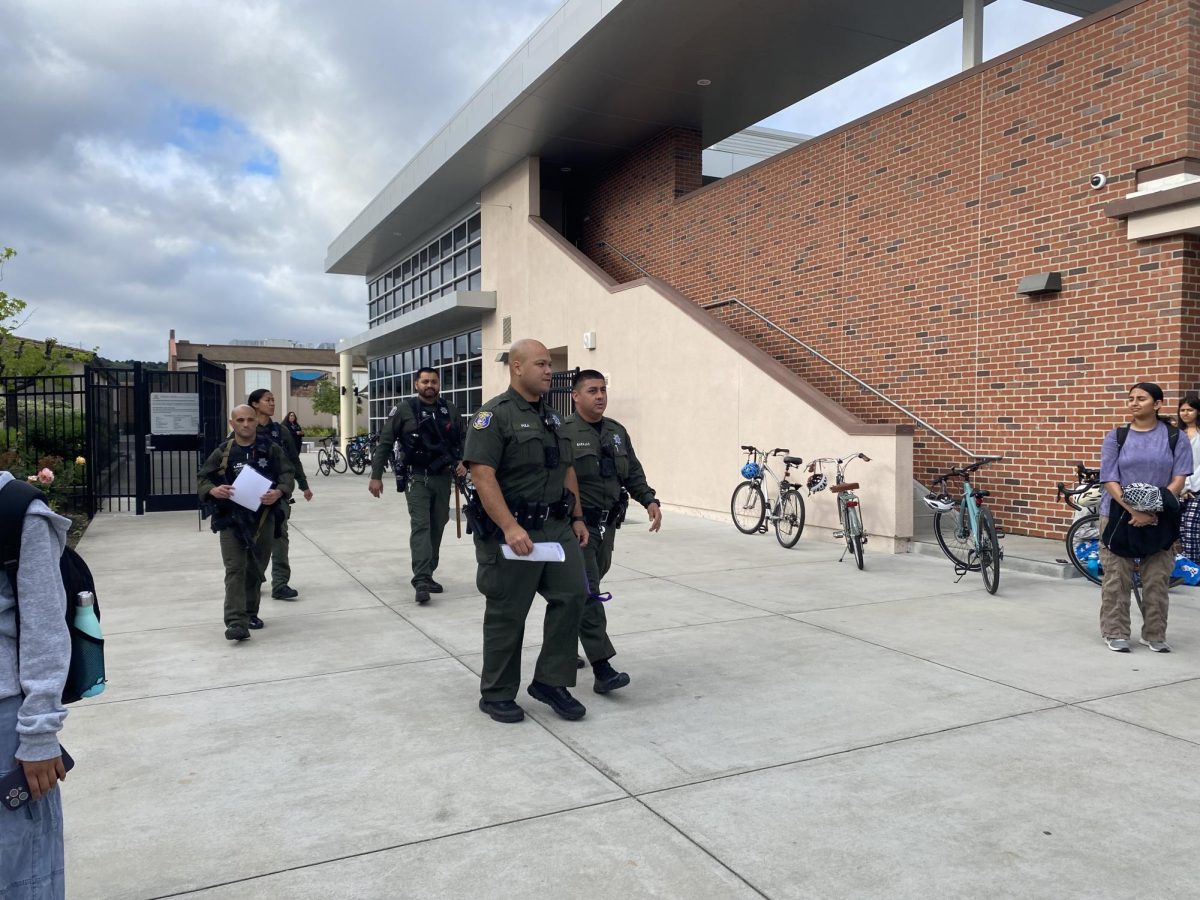At the beginning of the school year, Homestead High School senior and FUHSD Student Board Representative Elisabeth Floyd noticed the emergence of a recurring issue in the student feedback reports she collects every other week: lack of accessibility to transportation. The concern was especially common among students attending Fremont High School and HHS, and Floyd was aware the issue had existed for a while, stemming from the closure of Sunnyvale High School in 1981.
“When Sunnyvale High School closed, all the students who live in North Sunnyvale now go to Fremont High School, so commutes can actually be up to an hour and 15 minutes,” Floyd said. “How long it takes you to get to and from school impacts everything from getting to school on time and succeeding in your classes to how you’re able to participate in extracurricular activities and find a community. And it’s not a new issue. It’s existed for a while and there’s always been input from the community, both from Fremont High School and Homestead High School.”
Floyd began discussing solutions with FUHSD Trustee Rod Sinks, leading to the creation of the Sunnyvale Mobility Advocacy Group last October. Sinks, a former Cupertino mayor who contributed to the city’s implementation of Via, now known as the Silicon Valley Hopper, in April of 2023, suggested expanding the microtransit option to Sunnyvale. Floyd recalls that the adoption of the Silicon Valley Hopper seemed like a “low-hanging fruit that we could take advantage of,” especially since it was already undergoing implementation in neighboring areas such as Santa Clara.
“If the city of Sunnyvale were to adopt this service, it wouldn’t just benefit students — it would benefit a lot of different residents right in the city,” Floyd said. “But my goal is to highlight how it would impact student life. Ultimately, it comes down to the City Council to make this decision, if they’re going to adopt it or not, and there’s a lot of them and they’re all adults — they’re not hearing from students constantly. So I really wanted to actually talk to them, educate them about the issue and how we would benefit from it so that they can hear student voices.”
Using her connections with intradistrict groups such as Equity Task Force, FUHSD Climate Collective and Interdistrict Council (IDC), Floyd helped mobilize students across the district to gather student data and collect feedback on transportation. She also focuses on organizing and supporting the rest of the students by sending out texts and emails, hosting Zoom sessions to answer questions and helping other student advocates prepare public comments for City Council meetings.
The advocacy group is currently preparing for the March 26 Sunnyvale local city council meeting where they will have the opportunity to publicly advocate for the implementation of Hopper in Sunnyvale to Councilmembers and present their findings. Decisions will be finalized by Councilmembers before the deadline for the Transit and Intercity Rail Capital Program (TIRCP) grant application which will allow the city access to funding if the plans are passed.
“That’ll be a really valuable space for them to hear from us,” Floyd said. “Trustee Rod has been meeting one-on-one with City Council members. We also got other groups to send letters of support. Last week on the board, we passed approval to send a letter from our school board to the City Council. It basically says, ‘We want this, please consider it, the school board supports it,’ and then some other groups in the city of Sunnyvale.”
MVHS & CURRENT EFFORTS
The Sunnyvale Mobility Advocacy group currently aims to expand the Silicon Valley Hopper to Sunnyvale with full residential access to compensate for the vast size of the city. The expansion would also extend the Silicon Valley Hopper’s current working hours — 7 a.m. to 7 p.m. on weekdays and 9 a.m. to 5 p.m. on Saturdays — to 9 p.m. in Sunnyvale. As a result, a second measure students are advocating for entails extending the hours to 9 p.m. in Cupertino as well.
Extended hours will tackle inequities that arise with transportation for after-school activities, according to MVHS representative of Sunnyvale Mobility Advocacy group Samhita Kashyap. Through a school-wide survey of 111 MVHS students, Kashyap discovered that 54% believe extending Silicon Valley Hopper hours to 9 p.m. would significantly benefit them and 33% of students don’t find use in the Hopper due to its hour limitations.
“If students want to participate in extracurricular activities, and that is correlated with their usage of the Hopper, that must mean that there is an inequity in transportation to these activities,” Kashyap said. “A majority of the students who say extending the hours will benefit them also happen to be students who don’t currently use the Hopper. That means that the Hopper’s hours are limiting kids’ access to transportation, which is an inequity of transportation.”
Limitations for sports extracurricular activities are among the most affected, according to Kashyap’s data. Within the data, 73 students out of the 111 responses participate in sports, and 45 of those students say they will benefit by extending Hopper hours. The extension will also tackle issues that arise with transportation for sports games — while sports practices often occur from about 4 p.m. to 6 p.m., sports games often take place past Hopper’s hours of operation.
“If 54% of those students who were surveyed said that they would be benefited in extracurricular participation if the Hopper was extended to 9 p.m., just take 54% of students at MVHS as a whole — that’s already 1,000 students,” Kashyap said. “If there are students who are already participating in sports who feel there’s an inequity in transportation to these events, what about the students who don’t even participate in sports who might want to? It draws the question of how many students aren’t participating because of equity issues and transportation.”
Aside from time limits, Kashyap’s data shows that regardless of a student’s ability to drive, reliance on the Hopper remains relatively the same with the percentage of drivers and non-drivers who frequently use Hopper being 15% and 16% respectively.
While the Hopper is already implemented throughout most FUHSD schools, Kashyap says the data within schools benefited by the accessible transportation can be used to demonstrate the advantages of implementing the Hopper in Sunnyvale. Kashyap points out that the time cut-off as well as the discrepancy in transportation accessibility between cities poses challenges for students traveling throughout different cities, highlighting the need for comprehensive implementation.
“Council is politics,” Kashyap said. “You need people to represent the issues that the people see. So after giving evidence binders to the panel, the panel decides whether it’s an important thing that they want to execute, and the city’s budgeting and finances are planned appropriately so that things like this are executed by the respective department.”
Further benefits of expanding Hopper include allowing more affordable transportation options for senior citizens who can opt for the service instead of potentially putting themselves and others at risk by driving. Aside from the benefits of energy conservation, Hopper’s implementation of electric cars allows cities to receive grants to fund the transportation program, reducing the fare for riders. Costs for implementing Hopper in Sunnyvale will be price-matched by 50% by TIRCP, reducing the cost to $1 million, according to Kashyap.
“Even though our efforts are run by students and advocated by students, it’s not limited to benefiting students,” Kashyap said. “When you compare the costs to how much ever students are paying, it is more beneficial to the city than any other options.”
As Floyd, Kashyap and their senior counterparts within the advocacy group graduate at the end of the semester, they plan on continuing efforts by passing on resources and duties to next year’s IDC elects and equity task force members. Floyd says the role students play within advocacy lies largely in monthly meetings with the local city council where she hopes the issue of transportation will be continuously addressed.
“I fully trust that the school board is going to be working on this for a while because it’s a big issue,” Floyd said. “Hopper isn’t the only solution and it still is not accessible to everyone. It still costs money and some parents still might not feel comfortable if their students are using a service like this. I don’t have a long-term plan right now, but it’s kind of just been picking up issues that come up and seeing what resources we can utilize and try to push for.”
Correction 3/27/24: An earlier version of this article stated the Sunnyvale City Council budget was $35 million. The information was unreliable and is now redacted.


























